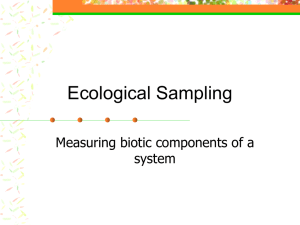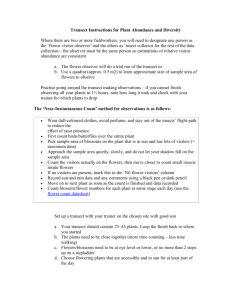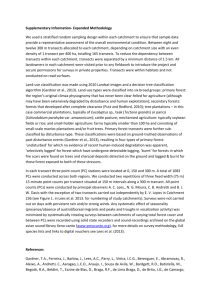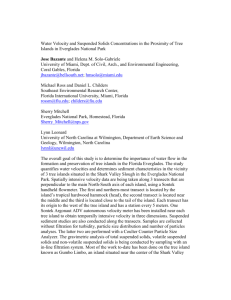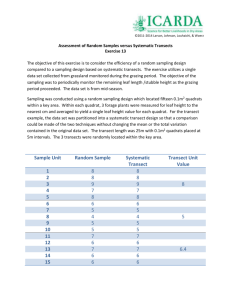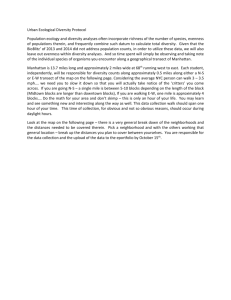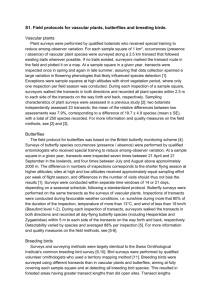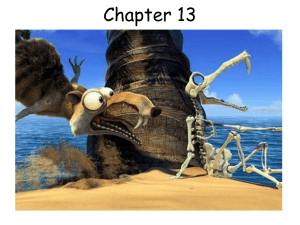Soft substrate mollusc species distribution on the Luiche platform, with... for lake level and paleoecological reconstruction
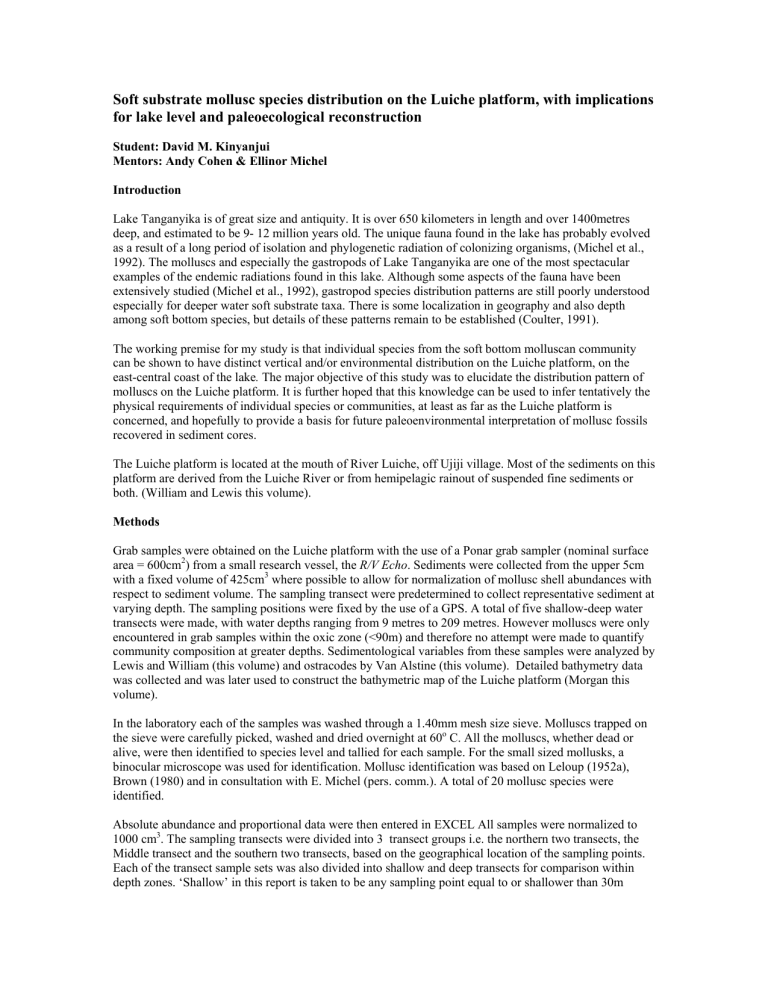
Soft substrate mollusc species distribution on the Luiche platform, with implications for lake level and paleoecological reconstruction
Student: David M. Kinyanjui
Mentors: Andy Cohen & Ellinor Michel
Introduction
Lake Tanganyika is of great size and antiquity. It is over 650 kilometers in length and over 1400metres deep, and estimated to be 9- 12 million years old. The unique fauna found in the lake has probably evolved as a result of a long period of isolation and phylogenetic radiation of colonizing organisms, (Michel et al.,
1992). The molluscs and especially the gastropods of Lake Tanganyika are one of the most spectacular examples of the endemic radiations found in this lake. Although some aspects of the fauna have been extensively studied (Michel et al., 1992), gastropod species distribution patterns are still poorly understood especially for deeper water soft substrate taxa. There is some localization in geography and also depth among soft bottom species, but details of these patterns remain to be established (Coulter, 1991).
The working premise for my study is that individual species from the soft bottom molluscan community can be shown to have distinct vertical and/or environmental distribution on the Luiche platform, on the east-central coast of the lake . The major objective of this study was to elucidate the distribution pattern of molluscs on the Luiche platform. It is further hoped that this knowledge can be used to infer tentatively the physical requirements of individual species or communities, at least as far as the Luiche platform is concerned, and hopefully to provide a basis for future paleoenvironmental interpretation of mollusc fossils recovered in sediment cores.
The Luiche platform is located at the mouth of River Luiche, off Ujiji village. Most of the sediments on this platform are derived from the Luiche River or from hemipelagic rainout of suspended fine sediments or both. (William and Lewis this volume).
Methods
Grab samples were obtained on the Luiche platform with the use of a Ponar grab sampler (nominal surface area = 600cm 2 ) from a small research vessel, the R/V Echo . Sediments were collected from the upper 5cm with a fixed volume of 425cm 3 where possible to allow for normalization of mollusc shell abundances with respect to sediment volume. The sampling transect were predetermined to collect representative sediment at varying depth. The sampling positions were fixed by the use of a GPS. A total of five shallow-deep water transects were made, with water depths ranging from 9 metres to 209 metres. However molluscs were only encountered in grab samples within the oxic zone (<90m) and therefore no attempt were made to quantify community composition at greater depths. Sedimentological variables from these samples were analyzed by
Lewis and William (this volume) and ostracodes by Van Alstine (this volume). Detailed bathymetry data was collected and was later used to construct the bathymetric map of the Luiche platform (Morgan this volume).
In the laboratory each of the samples was washed through a 1.40mm mesh size sieve. Molluscs trapped on the sieve were carefully picked, washed and dried overnight at 60 o C. All the molluscs, whether dead or alive, were then identified to species level and tallied for each sample. For the small sized mollusks, a binocular microscope was used for identification. Mollusc identification was based on Leloup (1952a),
Brown (1980) and in consultation with E. Michel (pers. comm.). A total of 20 mollusc species were identified.
Absolute abundance and proportional data were then entered in EXCEL All samples were normalized to
1000 cm 3 . The sampling transects were divided into 3 transect groups i.e. the northern two transects, the
Middle transect and the southern two transects, based on the geographical location of the sampling points.
Each of the transect sample sets was also divided into shallow and deep transects for comparison within depth zones. ‘Shallow’ in this report is taken to be any sampling point equal to or shallower than 30m
depth. ‘Deep’ is defined as any depth greater than 30M. For each transect pie charts showing the abundance of mollusc species at the two depths were constructed. Diagrams showing species abundance with depth were also constructed for each transect. The species vs. depth profiles were constructed for both absolute normalized data and relative abundance percentage data.
Results
The northern transects had a total of 22 sampling points that ranged from 10m to 107m in depth (Figure 1).
Out of the 22 sampling stations, 5 samples (22.7%) had no mollusks (GB 18 (48m), GB 6 (53.9m), GB
11.,GB 13, GB12 (>90M)). The middle transect had 10 sampling points out of which 3 samples (33.3%) had no molluscs i.e. GB 69 (48m), GB 62 AND GB61 (> 88m) (Figure 2). The southern transects had 19 sampling points out of which 8 samples (42.1%) had no molluscs. They include GB 32 (18m), GB39
(58.2m), GB 40 (68.5m), GB 41 (80M) (Figure 3). Only Tiphobia and Tomichia persisted below 60m depth, with both in very small numbers below that depth. Samples with no molluscs are generally skewed to the deeper waters especially in depths below 80m.
The Northern transects had the highest species richness with a total of 17 species. In this transect GB 2
(20m depth) had the highest single sample species richness at 7 species. The largest abundance count was in GB 5 (38m depth) with a total of 514 individuals / 1000cm 3 .
The Middle transect had a total of 11 species. GB 66 (48 m depth) had the highest single sample species richness in this transect with a total count of 7 species. Sampling point GB 66 also had the highest abundance in this transect with a count of 189 individuals / 1000cm 3
A total of 13 species were recorded in the Southern transect. GB 36 (29.4m depth) had the highest single sample species richness in this transect with 6 species, while GB33 (10m depth) had the highest abundance count with 300 individuals / 1000cm 3. (See table in appendix).
In the shallow waters C .burtoni, V. westi and C. kirki dominate in the northern transects. In the Middle transect, A. giraudi , C .burtoni, and T. horei dominate the shallow depths whereas in the southern transects, S .minuta, C. burtoni and M. multisucata are the dominant species . C. burtoni is the only dominant taxa common in all transects (see shallow water pie diagrams).
In deep waters, A..giraudi, T .horei
, and T. gulleimei dominate in the northern transects. In the middle transect S .minuta, S .gracilis and T .horei are the dominant species, whereas in the southern transect,
T .gulleimei
, S. minuta and T .horei define the dominant species assemblage. T .horei
is common in all the transects, whereas T .gulleimei
is common only in the Northern and Southern transects (see deep water pie charts).
Discussion
In regard to vertical distribution, no clear zonation is apparent in the mollusc species but rather there appear to be broad associations between species, some of which correspond to depth. This is in line with the findings of Coulter (1991) and Leloup (1951a, 1953). There is a clustering of species between 20m to 60m depth. This I define as the ‘optimum mollusc zone’ in the present area of study, which should be readily apparent in sediment cores sampling this paleodepth range. However certain species appear to be restricted to specific environments. For example in the present study Lavegeria nassa was found only in the shallow waters. Vinundu westi was found only in the shell lags irrespective of the depth of occurrence of the shell lags.
Coulter (1991) considered Srynolopsis, Chytra, and Anceya to prefer shallow waters with sand that contain detritus. In the present study Chytra was dominant in the shallow waters of the Northern transect at 37%.
Srynolopsis was found to be dominant in the shallow waters of the Southern transect (62%), and the deep waters of the middle transect (31%). Anceya was found to dominate in the shallow waters of the middle transect (51%) and the deep waters of the Northern transect (45%).
Tiphobia is considered to be a deep water species that dwells on muddy bottom (Coutler, 1991). In the present study however, Tiphobia was present at both shallow and deep zones in the Northern and the Middle transects and was only restricted to
the deep waters in the Southern transect. A comparison with grain size data variation however does not reveal any correlation with the number of Tiphobia shells in any of the transects. In general, there seem to be fewer molluscs per unit volume in the zones with very high amount of clays compared to the zones with high proportions of sand (> 10% sands, see table in appendix). Comparison of the mollusks data with TOC and TIC values (which generally increase with decrease in grain size, Lewis this volume) does not reveal any clear control on the species distribution patterns. The ‘optimum mollusks zone’ in all the transects is characterized by TOC values of 2- 3%. However, the relationship with TIC is not clear. The total number of mollusc species with depth correlate with dissolved oxygen depth profile. There is a sudden decrease in mollusk abundance below 60m depth which coincides with the oxicline (60- 80m) on the Luiche platform.
Below the oxicline in this zone (80m depth) mollusks are rare or absent (Figure 4).
Overall, the relationship between mollusk species distribution with depth, grain size, TOC and TIC is not simple. One of the factors that appear to strongly influence mollusc species distribution patterns in the present study area is the nature of the bottom. Depth on the other hand seems to determine the threshold depth of mollusc species occurrence, 80m in the present study below which no molluscs are found. Within the ‘optimum molluscs zone’ (20- 60m depth in this platform), depth zonation among different species is not clear and probably reflects the patchy distribution of species across the delta surface.
Conclusion
Although the transects were divided into shallow and deep zones, there are no strong stenotypic tendencies among most mollusc species on the Luiche platform as far as depth is concerned. There appear to be other factors whose interactions are complex that primarily control mollusc species distribution patterns, such as oxygen levels, which may in turn vary with depth or local environment. However, the predictability of species’ occurrences is limited by the apparently patchy distribution of most species across the delta surface.
Acknowledgements
I am deeply indebted to Andy Cohen for his numerous invaluable suggestions during all stages of this project. I express the same sentiments towards my second mentor E. Michel for helping me during the lab work. Many thanks to all the ‘geo team’ members including, Kiram, R.J. Hartwell, Jana, Leah, Christine and Emanuel for the good company and encouragement.
References
Brown, D. 1980. Freshwater snails of Africa and their Medical importance. Taylor and Francis publishing company; London.
Coulter, G.W. 1991. Composition of the flora and fauna:In Coulter G.W.(ed) Lake Tanganyika and its life. Oxford University Press,
London. Pp 200- 274.
Leloup, E. 1950a. Lamellibranch. Resultats scientifiques de l’ exploration hdrobiologique du Lac Tanganika (1946- 1947). Institute
Royal des Sciences Naturalles de Belgique,3(2): 27-43.
Michel, A.E., Cohen, A.S., West,K., Johnston, M.R. and Pat, P.W. 1992. Large Africa Lakes as natural laboratories for evolution:
Examples from the endemic gastropod fauna of Lake Tanganyika. Mitt. Internat. Verein. Lmnol., Stuttgart. Pp.85- 99.
MAJOR SHALLOW WATER SPECIES (%)
N-TRANSECTS
7.1081
2.95
20.69
25.66
C.burtoni
V.w esti
C.kirki
Others
MAJOR DEEP WATER SPECIES (%).
N-TRANSECTS
16.829
6.1
8.758
25.79
A.giraudi
T.horei
T.gulleimei
Others
MAJOR SHALLOW WATER SPECIES
VS. DEPTH
N.TRANSECTS
60
80
100
0
20
40
NO.
INDIVIDUALS/1000CC
0 20 40 60 80
10
0
C.burtoni
V.westi
C.kirki
60
80
20
40
100
MAJOR DEEP WATER SPECIES
VS.DEPTH
N-TRANSECTS
0
0
NO. OF INDIVIDUALS/1000CC
50 100 150
A.giraudi
T.horei
T.gulleimei
% OF MAJOR SHALLOW WATER SPECIES
VS. DEPTH
N-TRANSECTS
60
80
100
0
20
40
%
0 20 40 60 80 100
C.burtoni
V.westi
C.kirki
% OF MAJOR DEEP WATER SPECIES
VS.DEPTH
N-TRANSECTS
40
60
80
0
20
%
0 20 40 60 80 100
100
A.giraudi
T.horei
T.gulleimei
Figure 1: Mollusc abundance and major taxa for northern transects (N. of Luiche River Delta Front)
Figure 2: Mollusc abundance and major taxa for middle transect (Luiche River Delta Front).
MAJOR SHALLOW WATER SPECIES
(%).
M-TRANSECT
MAJOR DEEP WATER SPECIES (%)
M-TRANSECT
1.8
8.7
11.4
5.4
16.2
A.giraudi
C.burtoni
T.horei
Others
S.minuta
S.gracilis
T.horei
Others
7.3
9.4
10.1
MAJOR SHALLOW WATER VS. DEPTH.
M- TRANSECT
20
40
60
80
100
0
0
NO.OF INDIVIDUALS/1000CC
20 40
A.giraudi
C.burtoni
T.horei
% OF MAJOR SHALLOW WATER SPECIES
VS DEPTH
M-TRANSECT
20
40
60
80
100
0
%
0 20 40 60 80 100
A.giraudi
C.burtoni
T.horei
MAJOR DEEP WATER SPECIES VS.
DEPTH
M- TRANSECT.
0
NO.OF INDIVIDUALS/1000CC
0 20 40 60 80 100
20
40
60
80
100
S.minuta
S.gracilis
% OF MAJOR DEEP WATER SPECIES VS.
DEPTH
M-TRANSECT.
0
%
0 20 40 60 80 100
20
40
60
80
100
S.minuta
S.gracilis
T.gulleimei
MAJOR SHALLOW WATER SPECIES (%)
S TRANSECTS
MAJOR DEEP WATER SPECIES (%)
S TRANSECTS
3.06
61.94
29.9 3.06
151
S.minuta
C.burtoni
M.multisulcata
Others
4.973
5.52
6.33
T.gulleimei
S.minuta
T.horei
Others
MAJOR SHALLOW WATER SPECIES VS.
DEPTH
S-TRANSECTS
80
100
20
40
0
NO.OF INDIVIDUALS/1000CC
0 50 100 150
60
S.minuta
C.burtoni
M.multisulcata
MAJOR DEEP WATER SPECIES VS.
DEPTH
S TRANSECTS
NO. OF INDIVIDUALS/1000CC
20
40
0
0 20 40 60 80 100
60
80
100
T.gulleimei
T.horei
% OF MAJOR SHALLOW WATER SPECIES
VS. DEPTH
S-TRANSECTS
0
20
40
60
80
100
%
0 20 40 60 80
10
0
S.minuta
C.burtoni
M.multisulcata
% OF MAJOR DEEPWATER SPECIESVS
DEPTH
S-TRANSECT.
20
40
60
80
100
0
%
0 20 40 60 80 100
T.gulleimei
T.horei
Figure 3: Mollusc abundance and major taxa for southern transects (S. of Luiche River Delta Front).
Figure 4: Dissolved oxygen profiles for Luiche Delta area and total mollusk abundances by transect and depth.
DISSOLVED OXYGEN PROFILE-LUICHE
DELTA FRONT
Dissolved Oxygen [mg/L]
5.00
10.00
15.00
50
60
70
80
90
100
110
120
130
140
150
0
10
20
30
40
0.00
CTD
20.00
DO Probe
Winkler
Titrations
TOTAL ABUNDANCES BY TRANSECT &
DEPTH
# INDIVIDUALS/1000CC
0 200 40
0
60
0
10
30
50
70
90
110
Ntransect
Mtransect
Stransect
130
